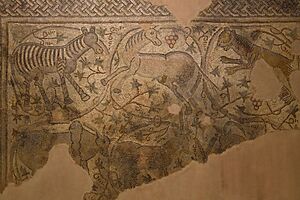Quaternary science facts for kids
| English name | Quaternary science |
|---|---|
| Date | Pleistocene Epoch (2.58 million years ago to about 11,700 years ago) and Holocene Epoch (11,700 years ago, begin after Pleistocene Epoch) |
| Duration | 2.58 million years ago – present day |
| Also known as | The study of Quaternary Period (ice age) |
| Motive | To understand the history of the Earth during the last 2.58 million years |
| Outcome | Ability to predict the upcoming or future changes in climate |
| Quaternary science was first studied in the nineteenth century by a French scientist – Georges Cuvier. | |
Quaternary science is a part of geology that studies the Quaternary Period. This time is often called the ice age. The Quaternary Period began about 2.58 million years ago and continues today. It is split into two main parts: the Pleistocene Epoch and the Holocene Epoch.
The main goal of Quaternary science is to understand everything that happened during these two epochs. This helps us learn about Earth's environment, ecosystems, and climate changes. By studying the past, scientists hope to predict future climate changes. A French scientist named Georges Cuvier first started studying Quaternary science in the 1800s.
Quaternary science is also very important for archaeology. It helps archaeologists understand archaeological records better. This field provides a clear timeline for studying human history.
Contents
What is Quaternary Science?
Quaternary science is the careful study of the Quaternary Period. It is a field that is always growing. New ways to research and date things are being developed all the time.
This science combines ideas from geography, biology, chemistry, and physics. It focuses on the time from 2.58 million years ago until now. Earth has been greatly shaped by events during the Quaternary Period. This includes many ice ages. A big part of Quaternary science is figuring out what happened during these ice ages. It also helps us understand today's ecosystems and climate changes by looking at their history.
A Look Back: History of the Quaternary Period
The Quaternary Period is a long stretch of Earth's history. It is divided into two main parts. The Pleistocene Epoch started about 2.58 million years ago. The Holocene Epoch began about 11,700 years ago. This is the time we live in now.
Studying the Quaternary Period began in Europe in the late 1700s. An Italian engineer named Giovanni Arduino first used the word 'Quaternary'. He used it to describe the four most recent periods of Earth's history. Later, scientists realized that the Quaternary was a time of big climate changes. Global temperatures were much colder than today. Louis Agassiz saw signs of a recent "Great Ice Age."
Georges Cuvier, a French scientist, was one of the first to really study Quaternary science. In the early 1800s, he suggested that some animals from the Pleistocene epoch became extinct. He thought this happened because of big environmental changes, like huge floods. This idea made him famous.
Scientists also started to think about what caused ice ages. James Croll, a Scottish scientist, had an early idea. He suggested that changes in Earth's orbit affect the global climate. He was also the first to understand how ice and snow reflecting sunlight (called ice-albedo feedback) could make climate changes even bigger. His ideas helped explain why glaciers formed.
In the 1900s, these ideas grew even more. Milutin Milankovitch, a Serbian scientist, became famous for his theory. He linked Earth's movements to long-term climate changes. He calculated how sunlight reaching Earth changed over millions of years. André Berger, a Belgian professor, also found periods when sunlight was much higher or lower than average. His work showed how these changes might be linked to climate shifts.
During the 20th century, new areas of Quaternary science appeared. These included palaeoecology (study of ancient environments), palaeontology (study of fossils), and palaeoclimatology (study of ancient climates). These fields helped us understand how the environment changed throughout the Quaternary Period.
New Discoveries in Quaternary Science
Quaternary science is always changing. New research is constantly being done and published. These studies provide new evidence and create new ways to understand the past.
For example, one recent study looked at the climate history of a freshwater area in the Andes mountains. Researchers studied an ancient pond to learn about past climates in South America. Another study explored how Molecular fossils can help track past sea-level changes. There are many more ongoing studies. Since Quaternary science covers 2.58 million years of history, there is still so much to discover!
Quaternary science is also very important in archaeology. Archaeology is the study of human history using old objects and remains. There are many types of archaeology. Some archaeologists study human remains (called bioarchaeology). Others study ancient plants (called paleoethnobotany). Some even study stone tools.
Quaternary science gives archaeologists a clear way to understand human studies. It helps them interpret archaeological records from all over the world. For example, it helps with chronology (the order of events). It also helps understand ancient environments and how sites were formed.
A key part of Quaternary science in archaeology is geochronology. This is the study of the ages and dates of Earth's materials, like rocks and fossils. It is very important for understanding the history of Indigenous Australia. This is because there are not many other ways to create a timeline for their ancient sites.
Quaternary science also helps archaeologists solve big problems. It helps them understand how humans impacted their environment in the past. It also helps explain how humans spread across the world and how their cultures developed. By providing valuable information about ancient environments, Quaternary science helps us learn about human evolution during the late Quaternary Period.
How Quaternary Science Affects Us Today
Quaternary science has a wide impact. It helps us understand how climate changes affected animals and humans. It also shows how living things adapted and how humans evolved. When a species adapts, it means it has changed to survive new conditions. In this case, it's how organisms react to climate changes.
Every species needs certain things to live and reproduce. These include environmental factors like climate and geology. But not all species react the same way to changes. Adaptation allows species to change and keep living in the same place even if the climate shifts. Some adaptations even involve changes to their genome (their genetic code).
Scientists have studied how past climate changes affected the number of different species today. This is called species richness. For example, researchers looked at palm trees (Aceraceae). They wanted to see how Quaternary climate changes affected where palms grow and how many different types exist. They found that Quaternary climate changes greatly affected the richness of palm species. They also learned that today's climate mostly controls where palms grow globally. The Quaternary climate had a smaller, but still important, effect.
Many studies show that Quaternary climate changes still affect species today. For instance, research in the Southeastern United States suggests that early Quaternary climate change had a big impact on how Cactus species spread and diversified in South America. Quaternary science also shows how big ecological shifts happened.
One study found that the extinction of large animals (called megafauna) during the late Quaternary Period had a huge effect. It caused several big ecological changes in North and South America. When these giant animals disappeared, our current ecosystem changed over time. The study suggested that if large species like megafauna go extinct, our ecosystem could be at risk. This is because megafauna were like "ecosystem engineers." Their disappearance likely led to more plant species, causing lasting changes to the ecosystem.
See also
- International Union for Quaternary Research
- Palynology
- 100,000-year problem
- Geochronology




